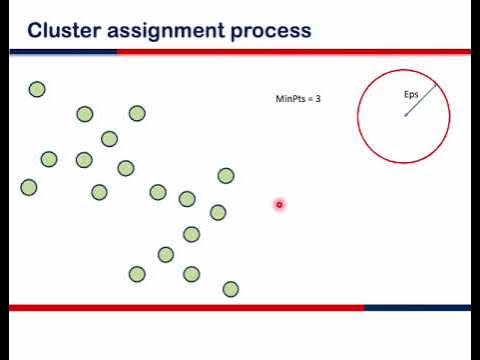Agglomerative Hierarchical Clustering Single link Complete link Clustering by Dr. Mahesh Huddar
Summary
TLDRIn this video, the hierarchical clustering algorithm is explained step-by-step using a set of six one-dimensional data points. The process begins with calculating pairwise distances between the data points and progresses through several iterations of merging the closest clusters based on minimum distances. The updated proximity matrix is shown after each merge, culminating in a final cluster formed by combining all the points. The video concludes by demonstrating the resulting dendrogram, visually representing the clustering process. This clear and detailed explanation makes hierarchical clustering easy to understand for viewers interested in data analysis.
Takeaways
- 😀 Hierarchical clustering is a method used to group data points based on their similarities.
- 😀 The given dataset consists of six one-dimensional data points: 18, 22, 25, 27, 42, and 43.
- 😀 A proximity matrix is constructed by calculating the distances between each pair of data points.
- 😀 The distance between each pair of points is calculated and stored in a matrix format for easy reference.
- 😀 The algorithm merges the two closest data points or clusters at each step, based on the minimum distance in the proximity matrix.
- 😀 In the first step, 42 and 43 are merged into a cluster, as they have the smallest distance of 1.
- 😀 After merging, the proximity matrix is updated by removing the merged points and recalculating the distances.
- 😀 The process of merging and updating the proximity matrix continues iteratively until all data points form a single cluster.
- 😀 A dendrogram is used to visually represent the hierarchical structure of the clusters formed at each step.
- 😀 The final dendrogram shows the sequence of cluster merges and the distances at which they occur, providing a clear visualization of the clustering process.
Q & A
What is hierarchical clustering?
-Hierarchical clustering is a method of cluster analysis that seeks to build a hierarchy of clusters. The algorithm progressively merges data points or clusters based on their proximity, resulting in a dendrogram or tree-like structure.
What data points are used in the example for hierarchical clustering?
-The data points used in the example are 18, 22, 25, 42, 27, and 43. These are one-dimensional data points.
How is the distance between the data points calculated in the hierarchical clustering example?
-The distance between the data points is calculated as the absolute difference between any two points, since the data is one-dimensional.
What does the proximity matrix represent in hierarchical clustering?
-The proximity matrix represents the distances between each pair of data points. It is a key part of the hierarchical clustering process, used to determine which data points or clusters should be merged at each step.
What is the first step in the hierarchical clustering process?
-The first step is to calculate the distance between all pairs of data points and construct the proximity matrix.
What is the significance of the minimum distance in hierarchical clustering?
-The minimum distance is crucial because it determines which two data points or clusters should be merged at each step. The algorithm repeatedly merges the closest points or clusters based on the smallest distance.
What happens after merging two data points in the proximity matrix?
-After merging two data points, the corresponding row and column in the proximity matrix are removed, and a new row and column representing the newly formed cluster are added. The distances to other clusters are recalculated.
What is the role of the dendrogram in hierarchical clustering?
-The dendrogram visually represents the hierarchical structure of the clusters. It shows how the clusters are formed by merging data points or smaller clusters, with the height of the branches indicating the distance at which the merges occurred.
What was the smallest distance in the initial proximity matrix, and what did it result in?
-The smallest distance in the initial matrix was between the points 42 and 43, which was 1. This resulted in the merging of these two points into a single cluster.
How does hierarchical clustering stop, and what is the final cluster in the example?
-Hierarchical clustering stops when all points or clusters have been merged into a single cluster. In the example, the final cluster consists of the points 18, 22, 25, 27, 42, and 43, with a final distance of 15 between the two groups.
Outlines

Esta sección está disponible solo para usuarios con suscripción. Por favor, mejora tu plan para acceder a esta parte.
Mejorar ahoraMindmap

Esta sección está disponible solo para usuarios con suscripción. Por favor, mejora tu plan para acceder a esta parte.
Mejorar ahoraKeywords

Esta sección está disponible solo para usuarios con suscripción. Por favor, mejora tu plan para acceder a esta parte.
Mejorar ahoraHighlights

Esta sección está disponible solo para usuarios con suscripción. Por favor, mejora tu plan para acceder a esta parte.
Mejorar ahoraTranscripts

Esta sección está disponible solo para usuarios con suscripción. Por favor, mejora tu plan para acceder a esta parte.
Mejorar ahoraVer Más Videos Relacionados

K-means Clustering dengan Excel

Algoritma K-Means Analisis Cluster pada Data Mining Part 2

K Means Clustering Algorithm | K Means Solved Numerical Example Euclidean Distance by Mahesh Huddar

CS190 2P 3 2

#25 Hierarchical Clustering - Agglomerative & Divisive Algorithm |DM|

TEKNIK CLUSTERING UNTUK MENGANALISA DATA MAHASISWA
5.0 / 5 (0 votes)
